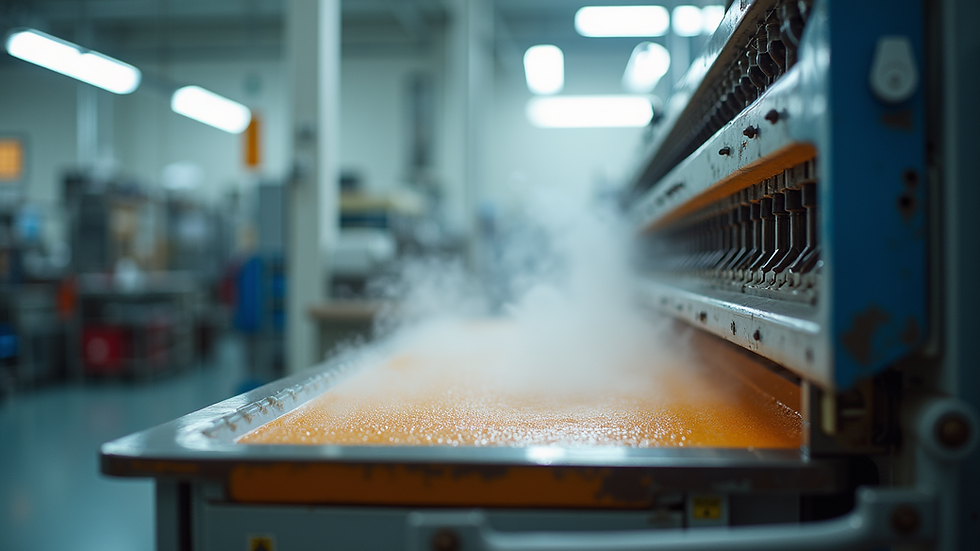Achieving 95 Percent Color Consistency in Fabric Production Through Innovative Lab Practices
- sknigamiiml
- Aug 20
- 4 min read
Lab to bulk dyeing is a critical topic in the textile industry. Every processing expert could share countless insights about it. Yet, when asked, "What is your lab's bulk actual result?" they often cite disappointingly low figures. Why is this disconnect between knowledge and implementation so common?
In this article, we will explore the lab-to-bulk dyeing approach and aim to create a Standard Operating Procedure (SOP) that ensures 95% shade repeatability for every processing unit in the lab. By adhering to this framework, bulk-to-bulk repeatability will significantly improve.
1.1 What is Lab-to-Bulk Dyeing?
Lab-to-bulk dyeing is the process of reproducing the shade achieved on a small-scale lab dyeing machine in large-scale bulk production. In simple terms, the color approved in the lab must match the shade of thousands of meters of fabric produced in bulk.
This practice is essential for maintaining quality and consistency in fabric production. However, the transition from lab to bulk frequently presents challenges that can cause color discrepancies. For instance, a leading manufacturer reported an average color deviation of 15% between their lab tests and bulk dyeing outcomes.
1.2 Why is Lab-to-Bulk Important?
Design Consistency: When a designer chooses a color for a collection, it tells a specific story. If the bulk fabric doesn't match, the integrity of that story falters.
Commercial Impact: The costs associated with re-dyeing, shade corrections, or product rejections can add up quickly. According to the Textile Exchange, re-dyeing can increase production costs by as much as 20%.
Brand Trust: Frequent color mismatches can damage relationships with international buyers. Statistics show that 70% of buyers consider consistency critical when selecting suppliers.
Sustainability: Every re-dyeing process wastes water, chemicals, and energy. This goes against Environmental, Social & Governance (ESG) commitments, which are becoming more crucial in today’s market.
1.3 Common Challenges in Lab-to-Bulk Dyeing
Despite the importance of achieving color consistency, several challenges obstruct the successful execution of lab-to-bulk dyeing:
Equipment Differences: The technology and capacity of dyeing machines in labs versus bulk production can vary significantly. For example, lab machines often use a different dyeing mechanism, which can lead to a 10-15% color mismatch.
Material Variability: Variations in the fabric composition across different batches can affect dye absorption. Inconsistent fiber blends may alter color outcomes.
Human Error: Differences in practices among operators can introduce inconsistencies in the dyeing process. For instance, a survey found that 40% of production errors stem from operator variations in dye application.
Environmental Factors: Changes in temperature, humidity, and other environmental conditions can significantly impact dyeing results.
1.4 Steps to Achieve 95% Shade Repeatability
To address these challenges and achieve high shade repeatability, the following two main strategies can be applied:
Standardize Procedures: Create a comprehensive SOP that details each step of the dyeing process, from preparation to finishing. For example, include precise measurements for yarn tension and dye concentrations.
Invest in Technology: Use advanced dyeing machines that can more closely replicate lab conditions during bulk production, such as machines capable of adjusting dye temperature and timing automatically.
Additionally, ensure that all operators undergo regular training to comprehend the SOP's significance. Monitoring environmental conditions, performing batch testing before production, and establishing strict quality control measures are also vital.
1.5 The Role of Technology in Lab-to-Bulk Dyeing
Technology is crucial in closing the gap between lab and bulk dyeing. Innovations like digital dyeing machines and color management software greatly enhance color reproduction accuracy.
Digital Dyeing Machines: These provide precise control over dye application, dramatically reducing the risk of human error. For instance, a company that implemented digital dyeing observed a 25% reduction in mismatches.
Color Management Software: This software assists in analyzing color data and predicting dye behavior on different fabrics, leading to improved decision-making and fewer last-minute changes.
1.6 Case Studies: Successful Lab-to-Bulk Implementations
Several companies have effectively enhanced their lab-to-bulk dyeing processes. For example, a prominent textile manufacturer invested in a digital dyeing machine, achieving a 90% shade match in bulk production. This led to a significant drop in dyeing costs and improved customer satisfaction.
A smaller fabric producer focused on training their team about color consistency. By having regular training sessions and stringent quality checks, they raised their shade repeatability to 92%. This not only reduced waste but also positively impacted their profit margins.
Final Thoughts
Achieving 95% shade repeatability in lab-to-bulk dyeing is vital for maintaining quality, trust, and sustainability in fabric production. Understanding and addressing the challenges through effective strategies is essential for companies looking to close the gap between lab results and bulk production.
As the industry evolves, embracing technology and standardizing processes will be crucial in overcoming the lab-to-bulk challenge. With commitment and the right strategies, color consistency is not just a possibility; it is an achievable reality.

By following these steps and committing to continual improvement, the fabric production industry can unlock the potential of lab-to-bulk dyeing. This ensures that every fabric tells a consistent story, regardless of production scale.




Comments